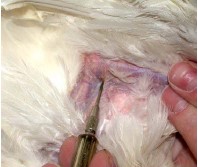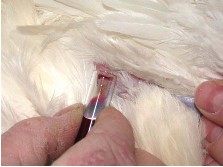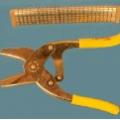AHL LabNote 3-Collecting and submitting poultry blood samples to the AHL
Updated May 2018
Flocks registered under the Ontario Hatchery and Supply Flock Policy may require periodic blood sampling for various tests offered under the Policy. Each registered hatchery applies annually to participate, and selects the test types and the level of testing they wish to have for their supply flocks. For some tests, it may be necessary to wing band the birds so that samples can be identified.
1. Supplies required:
- Submission forms (available from the Animal Health Laboratory (519) 824-4120, ext. 54530).
- Vials (polystyrene 3.5 mL, 55 x 12 mm, 4,000 vials per case), and caps for vials. Vials and caps are available from: Sarstedt Inc., 6373 Des Grandes Prairies, St. Leonard, Quebec, H1P 1A5; phone: 1 (888) 727-7833; fax: (514) 328-9391.
- Cardboard boxes (hold 100 vials each), are available from:
Bird Packaging, 670 Southgate Drive, Guelph, Ontario N1G 4P6; phone: (519) 836-3470
|
acceptable
|
|
unacceptable
|
|
Available from: Ketchum Manufacturing Inc., 396 Berkley Avenue, Ottawa, Ont. K2A 2G6 Phone: (613) 722-3451 |
|
2. Collecting blood samples
The best location for taking the sample is from the large vein under the wing.
For chickens, the person collecting the sample can hold the bird under their arm while drawing the blood.
 |
 |
 |
a. Using a sharp needle prick the vein. b. Let the vein bleed into a sample vial, filling the vial 1/3 to 1/2 full. c. Cap the vial and place it in the box. |
For turkeys, it is advisable to have someone hold the bird firmly by the feet, with the head facing the person taking the sample. Fold back a wing and puncture the wing vein, bleeding into the collection vial. Syringes and Vacutainers may also be used.
3. Handling blood samples:
- Keep samples at room temperature or slightly warmer until the serum has separated from the clot (serum is the clear or yellow fluid).
- Separation may take a couple of hours or overnight. Care should be taken not to overheat the samples. Likewise, they must be kept from being chilled or frozen.
- When the serum has separated from the clot, the samples should be refrigerated. If samples are being stored for more than 24 hours before sending to the lab, then the serum should be separated from the clot. The clot is fragile, so care should be taken to avoid having it rupture and the red blood cells mix with the serum.
For some tests, such as the Mycoplasma rapid plate test, samples should not be frozen. Please indicate when submitting samples to the lab that samples have been frozen.
4. Transporting samples:
Clients may find it convenient to personally deliver their samples to the laboratory, or they may wish to send them to us by courier. Free incoming courier service: The AHL will accept incoming courier shipments from Purolator from within Ontario only on an “incoming collect” basis. You must order your return waybill from AHL (ahl.supplies@uoguelph.ca). It is important to properly pack your samples for shipping, including an ice pack to keep them cool.
For further information, please contact: Linda Little Phone (519) 824-4120, ext. 54543, Fax (519) 827-0961. Email: llittle@uoguelph.ca







